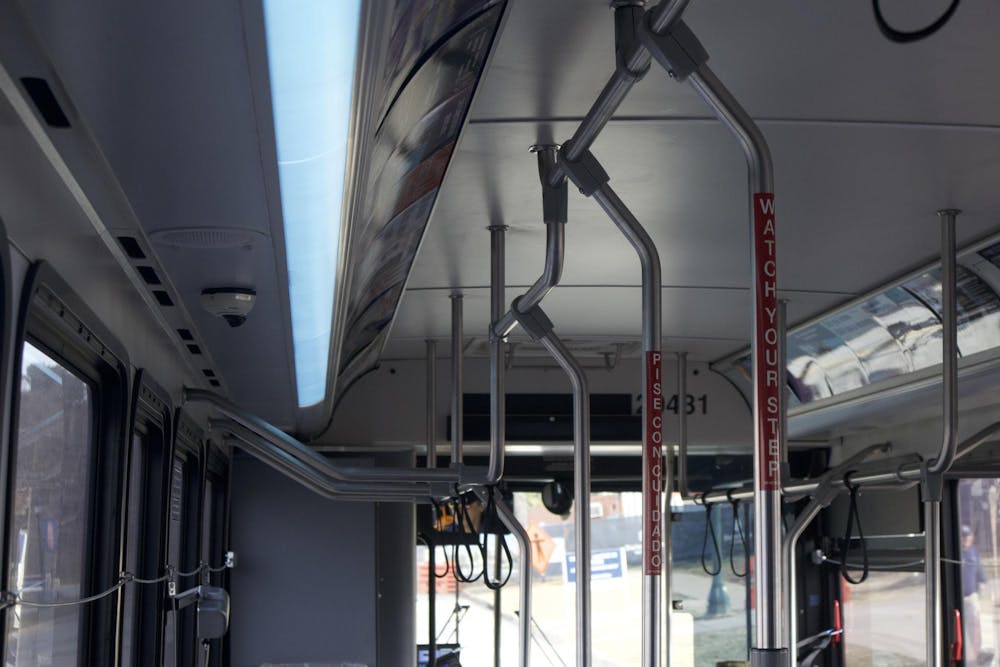The University Transit Service has made recent efforts to improve bus safety and enhance accessibility for UTS OnDemand, a free van service that shuttles University community members between locations after bus hours end. Goals for this initiative include increasing the accuracy of wait times and increasing the number of buses running throughout the day. Currently, students still report some concerns with the transit system.
UTS is a transit service run by the University which provides transportation free of charge to students, faculty, staff and visitors. Six lines operate Monday through Friday at various times and locations. Three of these lines also operate at later weekday hours — from 6 p.m. to 10 p.m. — and on weekends. UTS Night Pilot is an additional bus line which operates from 10 p.m. to 2 a.m., and UTS services also offer UTS OnDemand — also called SafeRide — which focuses on areas not covered by the Night Pilot’s route and operates from 10 p.m. to 5 a.m.
Because these buses serve a high volume of students and community members and cover a broad area both on- and off-Grounds, they often move between each stop slowly, meaning that estimated schedules are often inaccurate. Moreover, there is no system in place for bus drivers to verify that individuals boarding buses are University community members. SafeRide services also face high demand, with students waiting for vans to arrive for several minutes.
UTS General Manager Allison Day said in a statement to The Cavalier Daily that wait times for SafeRide services average eight to 10 minutes, depending on the time or day of the week.
Student Council representatives have attended meetings with UTS to support improved safety and effectiveness measures. One of the representatives working with UTS to make these changes is second-year College Representative Ian Travis. Travis began his work at Student Council last year through the Student Life Agency, which oversees University policies on transportation and dining. He said that a top priority is to increase bus frequency in the hopes of reducing wait times at busy street corners and improving student safety in high-traffic areas.
Currently, many students rely on electric scooters for timely transportation, but injuries due to scooter-vehicle collisions have been increasing in Charlottesville in recent years. Travis said more frequent buses could encourage safer commuting options.
“The biggest challenge we have in Charlottesville is traffic deaths,” Travis said. “That is a big issue [caused by] scooters. There's been multiple kids hit this year … I was once in an Uber with an [Emergency Medical Service] driver and he said the number one patient using the trauma rooms are University students who are on scooters and get hit by cars or fall off.”
The most recent change to address concerns of security is the addition of cameras on buses. All UTS buses have been equipped with security cameras since December 2024, according to Travis, who met with UTS to provide Student Council input on bus routes and safety initiatives.
These cameras provide recorded footage to the University Police Department. Travis said that installed security cameras are an important change and will help protect both the bus drivers and the students as they aim to increase security, monitor performance and record any incidents that may occur.
“There are issues with public transit and people sometimes don't perceive it being the most safe option,” Travis said. “So if we have security cameras to record any incidents … it would protect the bus drivers and it would protect the students. It's a mutual relationship.”
Alhaji Bah, UTS bus driver and second-year College student, said he believes the current security cameras help but believes that additional measures, such as requiring student IDs upon entry, can be taken for enhanced safety. He said that while he feels safe when transporting students, he worries that issues may arise when non-University associated individuals attempt to board.
“If there’s an emergency we radio our supervisor from the bus radio and then our supervisor is the one that [calls] UPD,” Bah said. “Sometimes updating isn’t very receptive, I feel like they could take things a little bit more seriously.”
Day said that bus drivers and UPD are connected through phone and radio, and that each bus is also equipped with an emergency radio call button. While students are not required to present University IDs to ride a bus, Day said they are required for UTS OnDemand services.
An additional safety measure UTS is introducing is the E-Jest, a 22-passenger electric minibus designed for narrow roads around the University, such as Wertland Street, which currently lacks regular transportation services. The E-Jest is set to begin service Feb. 21. Travis noted that the E-Jest idea was brought up by UTS originally, and Student Council encouraged them to move ahead with the plans.
“I think the E-Jest is the biggest thing you [can expect to] see,” Travis said. “We’re thinking about adding new routes to the 14th St. area [where] a big bus wouldn’t fill, but this one would, [allowing] for smaller, more accurate service projections.”
Alongside Christopher Joseph, co-director of the Student Life Agency and fourth-year College student, Travis has also helped make changes to the UTS Silver Line to make it more efficient. Previously serving neighborhoods with few University students, the route now connects Brandon Avenue’s Gaston and Ramazani Houses to the Corner, a popular off-Grounds area for students.
“The Silver Line used to be kind of a nonexistent route,” Travis said. “It stopped in neighborhoods that didn’t have U.Va. students, so [Joseph and I] took a map and drew a route that we thought was good from stopping at the new Brandon Ave., Gaston and Ramazani [Houses] and then up to the Corner.”
OnDemand operates through the TransLoc app which is used to view bus routes and order an OnDemand van. These vans connect more than 50 designated pickup spots at “blue-buttons” around Grounds — blue lights with a button which automatically connects an emergency phone call to 911. SafeRide primarily serves areas outside of the Night Pilot bus route, including 14th Street and distant on-Grounds housing, like Faulkner and Copeley Apartments. After Night Pilot ends at 2 a.m., SafeRide extends its coverage to include the Night Pilot route as well.
During Summer 2024, SafeRide was transferred from RMC, a Virginia-based event services organization, to UTS, making it a fully University-run program. While UTS has increased the number of available drivers, students still report long wait times — often exceeding those for Uber.
Second-year College student Selivia Habib, who frequently uses SafeRide when returning from the library late at night, said the service is useful but inconsistent. She said unpredictable wait times during SafeRide hours is a key issue, sometimes leaving her waiting alone for the van for several minutes.
“[I wish] they [could] see where I am and pick me up, rather than me clicking on the stop and having to walk all the way to them,” Habib said. “With them being unreliable [with] time, we miss each other. It’s either me going and waiting or them waiting for me and then leaving [without me].”
Travis encourages students to use the “blue-buttons” — emergency phones — to ensure they feel safe. There are 475 of these emergency phones around Grounds as well as nearby off–Grounds areas.
“I think U.Va. should keep educating students on resources through emails,” Travis said. “I think 911 is typically the best way, but those blue buttons do serve a purpose … I think that's something that's not been used enough.”
As the University has provided security cameras and increased transportation options and accessibility for students, Travis said he hopes that Student Council can continue working with UTS to address student feedback. He shared that, in the future, he would like to introduce an option to see when buses are full — often buses fill during busy periods and become difficult for students to access.
“Our focus is on looking for routes [that could be expanded] and also ensuring that students know when the buses are full. That's [an issue] we really want to respond to with the TransLoc app,” Travis said.







